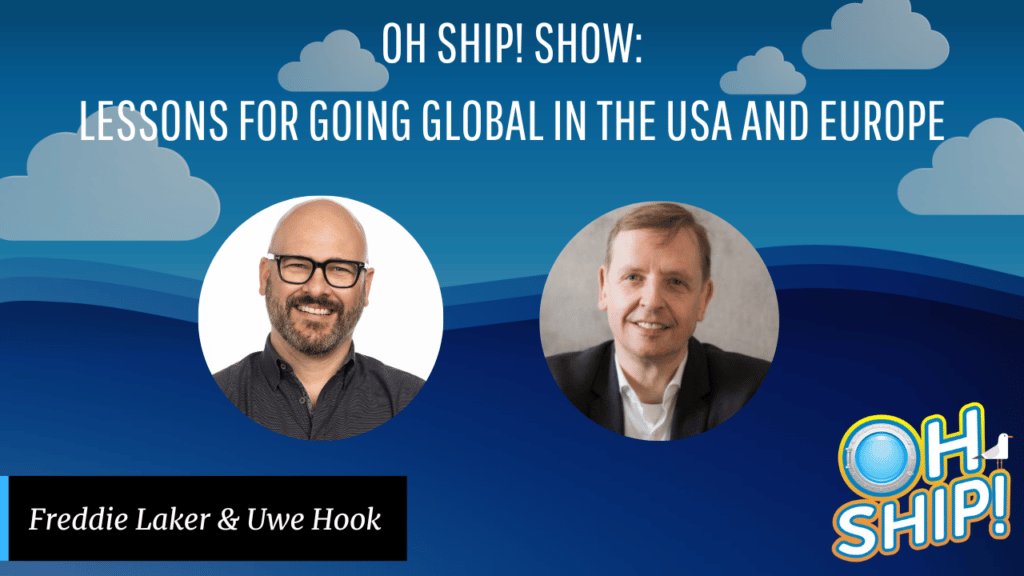
Uwe Hook, Interim CMO/CDO at Chameleon Collective, has had a robust career as a global entrepreneur. He’s served as CMO for high-profile firms like Co-op Financial Services as well as media leader for Gen-X, Direct Partners, and others. In his conversation with Freddie, he shared insights on expanding a business in the U.S. vs. Europe, key principles for building a global brand, and lessons learned from his “darkest hour” in business.
Uwe has earned the title of “global entrepreneur.” He’s German and currently lives in the Netherlands; he has also lived in Los Angeles while working with American brands like Honda and Acura, along with a few European brands. Over time, he became increasingly involved with global brands, having worked in the U.S. but possessing a cultural understanding of Europe. He’s worked with businesses across the APEC region, Latin America, and Europe—while working with Visa, he oversaw 56 countries in these regions.
“Global marketing is very challenging because it’s so complex. Normally you’re dealing with matrix organizations, and that’s not for everybody,” Uwe says. But for him, it’s a great joy to interact with people from around the world.
The Current Business Environment in Europe

Post-COVID inflation and the Ukraine war are creating a challenging environment right now in Europe, Uwe emphasizes. (Unless otherwise noted, he is speaking of continental Europe, as in regard to marketing, Great Britain is much more aligned with the U.S., he notes.) Inflation is holding steady at 10%. Last summer brought growing fears that some industries would shut down due to lack of access to energy, causing parts of Europe to deindustrialize.
Blackouts are no longer a looming fear, he says. But among the 27 countries in the EU, some are doing well while others are struggling. “The Netherlands is doing fine, Germany is doing okay, but then there are other countries in the south that are not doing as well, on the east,” Uwe says. “Europe is not ‘Europe’; we can talk about the U.S. as one block in some ways, even though there are regional differences, but Europe … you have to look at it country by country.”
“I think the biggest outlier in Europe is Great Britain,” he adds. “I think they’re in for a real challenge in the next three years.” It’s fallen into a real crisis, likely in part due to Brexit. England has had to open “warm rooms” in community centers where people without heat can warm up for a couple of hours, he notes.
Trends in Consumer Spending—and Industry Response
“This inflationary challenge that we are in right now is felt by everyone, but it’s not painful for everyone,” Uwe asserts. “It’s really painful for the bottom third or even … the bottom 50%. The top 10%—so luxury goods, for example—are doing really well globally, and also in Europe, because for them, it doesn’t make a difference.”
There’s still opportunity—it’s a bifurcated market, he underscores. “For people that make good money, it hurts, but they don’t really feel it,” he says of rising gas prices (currently around $8 a gallon). “It’s more like a little sting.” Despite perceptions of all of Europe being very densely populated, people do have long commutes in many places. “A big country like Germany has areas where people have to commute 40, 50 kilometers to go to work, and they really feel it. The ones that don’t have the good income, they are the ones that are really, really struggling,” Uwe stresses.
Regarding jobs, the layoffs in the tech world mostly affect software engineers right now. There are many open positions in restaurants and retail. “It’s an odd environment right now that I’ve never seen before,” Uwe says. “Unemployment is very low, but people feel very unstable right now. They feel like they don’t know what the future will bring.”
Mindset and Culture Differences Between the U.S. and Europe

“Some would call Americans naive, or some would call Americans curious,” Uwe remarks. “The acceptance of new technologies or new platforms is much, much higher in the U.S. than it is in Europe.”
This also relates to privacy law, he continues. “Many countries—specifically the big ones, like Germany and France—they’re very concerned about privacy; the EU is very concerned about privacy,” he explains. Twitter is facing real challenges with the EU Commission—and along with Google and Facebook, it’s being constantly slapped with steep fines.
“In America, it’s often, ‘Just do it and ask for forgiveness,’ but that really doesn’t work in the EU because it’s a very highly regulated environment,” he continues. To illustrate, you can actually ask Google to forget you, or information shared about you, in the EU—which is unheard of in the U.S—he says.
Advertising spend also differs. There’s much more advertising in the U.S.—1.4% of its GDP—while Germany spends less than half that percentage. In the U.S., Uwe feels the difference whenever he turns on the TV or steps outside—there are billboards everywhere, and the constant presence of ads has become completely normalized. That’s not the case in the EU.
Messaging strategy differs as well, as he learned quickly when he began working for B2B firms in Europe. “When it comes to messaging, for Americans, the marketing is often about a ‘big splash’—make a big splash, make a big impact—and the European is more about very slowly building. They’re not really comfortable making the big splash,” he explains. They’re not focused on taking down the competition. “They want to have better arguments than just an overwhelming marketing blitz.”
This stems from a more understated mindset, Uwe notes. In Amsterdam, for instance, people drive a small car in the city and park their big car outside of it; they want to drive it on the freeway but not for the sake of showing off.
European cultures tend to be more conservative in terms of spending, notes Freddie. This tends to create a stable economy, but when things rock the boat, a protective mindset kicks in. “I think spending is going to go way down, and I think people are going to really try and play it safe,” says Freddie. “I don’t think Europeans necessarily try to spend their way out of a recession like Americans might.”
Succeeding in the U.S. vs. Europe: Which Is Easier?
There’s never been a better time to expand globally, due to democratized access to the necessary infrastructure, says Freddie. There are solutions that streamline banking in any country, for instance. But how can you decide where to expand?
“It’s going to be harder for you to break through in Europe than it’s going to be to break through in the U.S.,” Uwe says. The tricky aspect of working in Europe is also what makes it so special—it contains a wealth of cultures and languages that are geographically very accessible, but from a marketing standpoint, very different.
Market size and complexity
Markets are smaller in Europe as a result of these differences, he notes. If you’re an entrepreneur in the Netherlands, expanding to Belgium may be a logical move—after all, the language is almost the same. Then, you could go to the Nordic countries, where everyone speaks English—you can still easily put web content together. “But then once I go into Germany, France, Italy, Spain, I have to regionalize, localize everything,” Uwe says. “Your website has to be in German, every communication has to be in German … You have to localize everything.” Complexity grows exponentially.
“On the other hand, when you go to America, you have a bigger market,” he continues. “The European market is bigger than the market in the U.S., but Americans are 40 to 50% richer than Europe, so your opportunity is bigger in America and the complexities are not there.”
While your messaging for a B2C product might vary between people in LA and Oklahoma, or between the big cities and small towns, you don’t have to regionalize (except when specifically trying to reach the Hispanic or Latino market, for example).
“Americans often talk about how divided the country may feel, but actually, on a lot of the buying behaviors, business behaviors, a lot of that stuff is actually really consistent,” says Freddie.
Prioritize learning from local people when working in a new market, Uwe says, noting that there’s often an “implied arrogance” in global headquarters. Let people regionalize the message rather than dictating a top-down approach.
Testing options
Further, you can test ideas much more effectively in the U.S., as it has a marketing system that lets you micro-test DMAs to see if a message works, says Uwe. In Europe, that isn’t feasible. “You almost have to commit to a country here and then hope for the best,” he asserts.
Openness to new products
“Americans are much more open to a new solution, product, or service than Europeans are. Europeans are socially very liberal, but they’re in general, when it comes to new ideas, very conservative,” he says. “They’re always very skeptical when new things come up.”
But ultimately, it comes down to what you’re selling, he emphasizes. “Forget about regionalization or localization—you have to take a really close look at your product,” he says. Companies often spend a huge amount on performance marketing to draw new people in (and sometimes that’s necessary). “However, if your product is not perfect, the churn is going to be so high that in the end, you have such a leaky bucket that all the investment that you made in performance will just go away. It’s really about the basics,” he says.
“You want to have the perfect product—a flawless, frictionless product or service people really want to use—and then you want to look really closely at your budget.”
At the same time, he cautions against responding to market changes by cutting down on performance marketing—or hiring mid-level people to run your operation. Keep the big picture in mind.
His “Darkest Hour” as a Global Entrepreneur
In 2005, Uwe was working in southern California for a global automotive company that was doing a website relaunch. At that time, this was a big deal, and he was managing the tech and creative teams producing the website and marketing materials. When asked to commit to a launch date, he confidently gave one that was just six weeks out, largely due to the confidence of the tech team. The CEO announced it—and the steering team told him they weren’t going to make that date. “All the blood was gone from my face … I aged 30 years in like a minute,” he says.
However, they kept the client and ultimately launched about three months later—and he learned a thing or two about setting more realistic deadlines!
Did you enjoy this post? Find Uwe on LinkedIn, and be sure to like and follow us for more insightful interviews!




